

Countries Compared by Military > Conventional arms > Exports > Per $ GDP. International Statistics at NationMaster.com. DEFINITION: Conventional arms transfers (1990 prices) - Exports (US$ millions) Refers to the voluntary transfer by the supplier (and thus excludes captured weapons and weapons obtained through defectors) of weapons with a military purpose destined for the armed forces, paramilitary forces or intelligence agencies of another country.
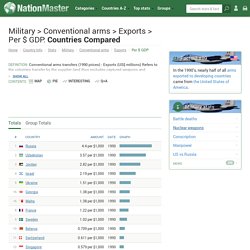
These include major conventional weapons or systems in six categories: ships, aircraft, missiles, artillery, armoured vehicles and guidance and radar systems (excluded are trucks, services, ammunition, small arms, support items, components and component technology and towed or naval artillery under 100-millimetre calibre). Per $ GDP figures expressed per 1,000 $ gross domestic product. Citation "Countries Compared by Military > Conventional arms > Exports > Per $ GDP. International Statistics at NationMaster.com", SIPRI (Stockholm International Peace Research Institute). 2005. US Foreign Aid to Israel. Arms industry. Workers assemble Browning-Inglis Hi-Power pistols at the John Inglis munitions plant, Canada, April 1944 It is estimated that yearly, over 1.5 trillion United States dollars are spent on military expenditures worldwide (2.7% of World GDP).[1] This represents a decline from 1990 when military expenditures made up 4% of world GDP.
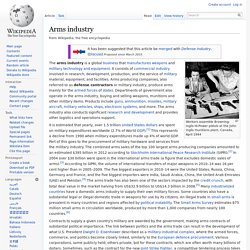
Part of this goes to the procurement of military hardware and services from the military industry. The combined arms sales of the top 100 largest arms producing companies amounted to an estimated $395 billion in 2012 according to Stockholm International Peace Research Institute (SIPRI).[2] In 2004 over $30 billion were spent in the international arms trade (a figure that excludes domestic sales of arms).[3] According to SIPRI, the volume of international transfers of major weapons in 2010–14 was 16 per cent higher than in 2005–2009. History[edit] Mideast arms sales surging to record $18b in 2015, with Saudis in lead. The Middle East is facing a burgeoning arms race which in 2015 is expected to include weapons purchases totaling an unprecedented $18 billion, the Guardian reported Thursday.
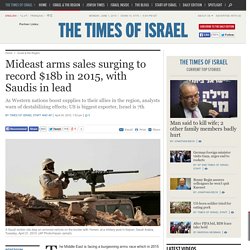
Get The Times of Israel's Daily Edition by email and never miss our top stories Free Sign up! According to the report, based on data gathered and published by IHS Jane’s and the Stockholm International Peace Research Institute, Western nations are selling an increasing amount of weaponry to the region’s top military buyers, which include Saudi Arabia, Egypt, Iraq, United Arab Emirates and Algeria. The arms sold include various aircraft, missiles and armored vehicles. While the West says it seeks to foster peace and stability in the region, the report notes, it is increasingly providing the Middle East’s major players with more and more tools with which to make war.
Omar Ashour, a Middle East security expert at Exeter University, warned that “the increases in arms sales are bound to be extremely destabilizing. America Has Been At War 93% of the Time – 222 Out of 239 Years – Since 1776 February 23, 2015 "ICH" - The U.S.
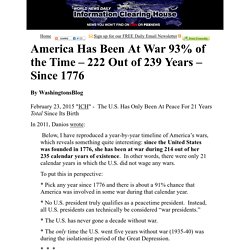
Has Only Been At Peace For 21 Years Total Since Its Birth Below, I have reproduced a year-by-year timeline of America’s wars, which reveals something quite interesting: since the United States was founded in 1776, she has been at war during 214 out of her 235 calendar years of existence. In other words, there were only 21 calendar years in which the U.S. did not wage any wars. To put this in perspective: * Pick any year since 1776 and there is about a 91% chance that America was involved in some war during that calendar year. * No U.S. president truly qualifies as a peacetime president. Instead, all U.S. presidents can technically be considered “war presidents.” * The U.S. has never gone a decade without war. * The only time the U.S. went five years without war (1935-40) was during the isolationist period of the Great Depression. * * * Here is a graphic depiction of U.S. wars:
INFORMATION CLEARING HOUSE. NEWS, COMMENTARY & INSIGHT. Statista - The Statistics Portal for Market Data, Market Research and Market Studies. Complementary currencies. Worldometers - real time world statistics. Jevons paradox. The Jevons paradox has been used to argue that energy conservation may be futile, as increased efficiency may increase fuel use.

Nevertheless, increased efficiency can improve material living standards. Further, fuel use declines if increased efficiency is coupled with a green tax or other conservation policies that keep the cost of use the same (or higher).[3] As the Jevons paradox applies only to technological improvements that increase fuel efficiency, policies that impose conservation standards and increase costs do not display the paradox.
History[edit] The Jevons paradox was first described by the English economist William Stanley Jevons in his 1865 book The Coal Question. Jevons observed that England's consumption of coal soared after James Watt introduced his coal-fired steam engine, which greatly improved the efficiency of Thomas Newcomen's earlier design. Cause[edit] Rebound effect[edit] Khazzoom–Brookes postulate[edit] Energy conservation policy[edit] Useful Online Calculators For Almost Every Educational and Life Need. Gapminder: Unveiling the beauty of statistics for a fact based world view.
Topics. All NES Games with Prices. NES price guide with 827 Games, accessories, and consoles.
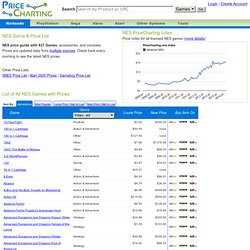
Prices are updated daily from multiple sources. Check back every morning to see the latest NES prices. Other Price Lists: SNES Price List | Atari 2600 Prices | Gameboy Price List. CPI inflation - summary of current international consumer price index inflation. Foundation for Economic Education. The Student Loan Crisis : Library. Economagic: Economic Time Series Page.